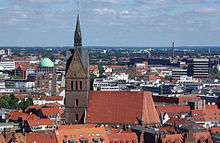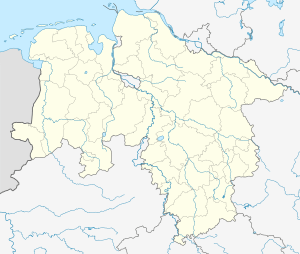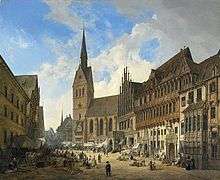Marktkirche, Hanover
The Marktkirche St. Georgii et Jacobi (Market Church of Sts. George and James), commonly known as Marktkirche ("The Church on the Marketplace"), is the main Lutheran church in Hanover, Germany. It was built in the 14th century and, together with the nearby Old Town Hall, is considered the southernmost example of the North German brick gothic (norddeutsche Backsteingotik) architectural style. The roof and the vaults of the naves were destroyed in an air raid in 1943 and restored in 1952.
| Market Church | |
|---|---|
| Market Church of Ss. George and James | |
| |
 Market Church, seen from Hanover's city hall | |
 Market Church Location within Lower Saxony | |
| 52°22′18″N 09°44′06″E | |
| Location | Hanover |
| Country | Germany |
| Denomination | Lutheran |
| Previous denomination | Catholic |
| Website | www |
| History | |
| Status | parish church bishop's preaching venue |
| Dedication |
|
| Consecrated | ~ 1360[1] |
| Architecture | |
| Functional status | active |
| Architectural type | hall church |
| Style | Brick Gothic |
| Groundbreaking | 1347[1] |
| Completed | 1366[1] |
| Specifications | |
| Length | 61.5 metres (202 ft) |
| Width | 26.6 metres (87 ft) |
| Nave width | 8 metres (26 ft) centre 5.4 metres (18 ft) lateral |
| Spire height | 97.26 metres (319.1 ft) |
| Materials | brick |
| Administration | |
| Parish | Marktkirchengemeinde, Hanover |
| Deanery | Hanover City (Stadtkirchenverband) |
| Synod | Lutheran Church of Hanover |
The church is a hallenkirche (hall church). Above the nave and two aisles rises a monumental saddleback roof. The high western tower was a symbol for the power and the wealth of the citizens of the town. It is still one of the highest towers in Lower-Saxony and a landmark of the city.
- Marktkirche, 2004
 Early 19th century
Early 19th century Interior, 2007
Interior, 2007
Altar
The main altar was carved of linden wood, around 1480. The front depicts the Passion of Christ in 21 scenes, following models of Martin Schongauer.[2] The back shows scenes from the lives of the two patron saints, Saint George and Saint James. The altar was moved to the Aegidienkirche in 1663 to make room for a Baroque altar. In 1856 it was taken to the Welfenmuseum and thus was not destroyed during World War II. It was returned to the Marktkirche in 1952.
Organ
An organ was installed in the turmraum (tower room) of the Marktkirche in 1893, which included parts of an instrument of the 17th century. This organ was destroyed in World War II.
Today's main organ is at the back wall of the southern aisle. The first instrument in that location was built in 1953 and 1954 by the organ builders Emil Hammer Orgelbau and Rudolf von Beckerath. It had 61 stops, four manuals and pedal. The prospekt (casing) was designed by Dieter Oesterlen and is a protected monument.
From 2007 to 2009, the instrument was rebuilt by Goll Orgelbau (Lucerne). The casing and about 50% of the pipes were kept. The new organ has 64 stops, 39 of them mostly using the older material.[3]
Bells
The Marktkirche has 11 bells.[4] The Christus- und Friedensglocke (Bell of Christ and Peace) is the biggest of Lower-Saxony and is only used on special occasions.
References
- "Baugeschichte". kirche-hannover.de (in German). Archived from the original on 29 September 2011. Retrieved 3 December 2011.
- Waldemar R. Röhrbein, Karl-Heinz Grotjahn M.A.: Marktkirche S. Georgii et Jacobi, in Stadtlexikon Hannover, p. 426f.
- Die Orgeln der Marktkirche Archived 2011-08-30 at the Wayback Machine (The organs of the Marktkirche) (in German)
- Plenum des Geläuts, Pfingstmontag 13. Juni 2011, 9:47 Uhr (14:35 min)
External links
![]()
- Marktkirche at MyTravelGuide
- Kurze Kirchengeschichte der Altstadt – short history of the churches in the Old Town, kirche-hannover.de (in German)